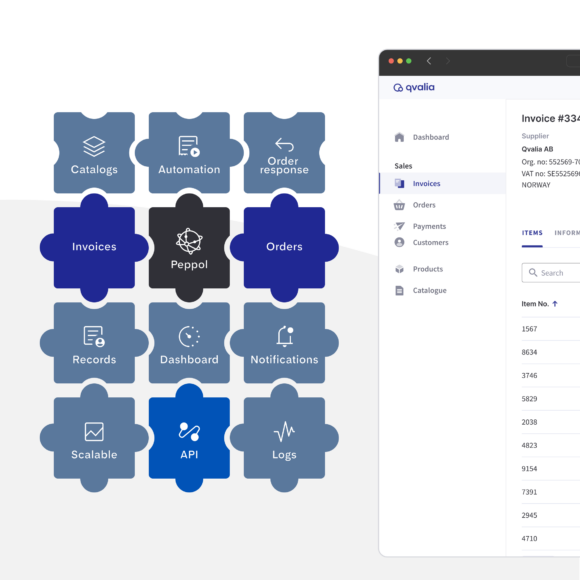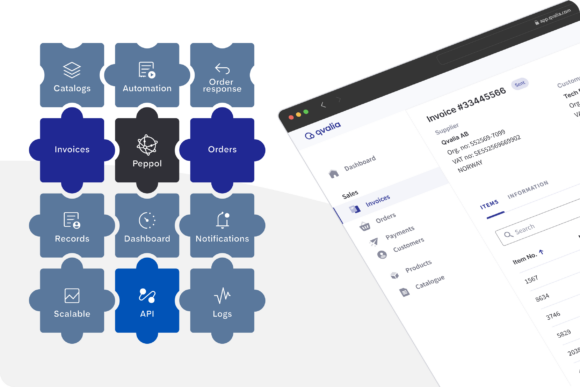
Adopting electronic orders represents a significant step in streamlining procurement and sales processes. Whether you run a multinational corporation or a small startup, implementing e-orders can significantly enhance efficiency, accuracy, and decision-making in digital commerce.
The emerging Peppol network, along with the standardized business message formats in the Peppol BIS Ordering profile, have made e-order technology more accessible than ever.
Implementing e-orders: an overview
Using e-orders can be a transformative technology. It’s implemented into critical processes, so choosing the right solution for your business needs a structured process. Some strategic decision-making is needed, and your requirements must be assessed.
For example, have you fully mapped how data currently flows through your business processes, and do you understand where bottlenecks or inefficiencies lie? Have you identified the segments of your transaction streams—be it with suppliers or customers—that could greatly benefit from digitization? Is there clarity among your team about the potential for automation within your existing workflows, and how might this reshape your financial operations? Moreover, how will the adoption of e-orders impact your relationship with stakeholders, both internal and external, and what measures will you take to ensure a smooth transition for all parties involved?
Whether your starting point is sales or purchasing processes, in a large or small organization, we summarized step-by-step tips in this buyer’s guide to e-orders.
1. Define your ideal process
Initiating the e-order journey begins with a clear vision. It’s crucial to:
- Map out how data will flow into and out of your company’s systems
- Spot automation opportunities across your processes, from validation and workflows to analytics
- Conceptualize the reports and analytics that will best serve decision-making
Understanding your end goal lays the groundwork for a successful e-order implementation.
2. Evaluation
Diving into the specifics of your existing processes is the next step:
- Determine which transactions, whether supplier or customer-focused, could benefit from digitization
- Examine your internal processes, both manual and digital, to assess their current efficiency and identify needs
- Decide on your approach to e-orders: will you send, receive, or both?
- Select the appropriate types of order messages, considering options like punchout and preferred responses
- Engage with internal stakeholders to ensure all perspectives are considered and addressed
This detailed evaluation will ensure that the e-order system aligns with your business requirements.
3. Technical Requirements
Understanding your technical infrastructure is essential:
- Identify data formats that are compatible with your business systems. Adopting Peppol formats can simplify integration by eliminating interoperability issues and unnecessary data conversion
- Choose an integration method, such as API or legacy tech SFTP, that fits your technical environment
- Plan any necessary data conversions to facilitate seamless system integration
4. Select a Peppol service provider
Choosing the right service provider is critical:
- Ensure the provider supports all necessary message types
- Inquire about their error-handling procedures
- Review their integration capabilities, user interface, automation features, and data management practices
- Evaluate the level of support and the quality of user documentation offered
- Assess their security measures and consider their business model, including pricing structures
- Request a product demo to gauge the quality and technological sophistication of their solutions
5. Roadmap Implementation
With a service provider chosen, it’s time to plan the integration:
- Outline the implementation of transaction flows, detailing steps for inbound and outbound transactions and communication with business partners
- Consider master data management, including customer and supplier registries, and plan for any necessary data migration
6. Onboarding
The final step is to finalize integration and onboard users:
- Register for Peppol IDs to facilitate seamless transactions within the Peppol network
- Integrate and implement the e-order system into your operations
- Conduct testing to ensure everything functions as intended
- Train and onboard internal users, assigning roles and permissions to streamline the process
Adopting e-orders can significantly enhance your business’s operational efficiency, providing better control over transactions and enabling a more streamlined workflow. Following this guide, your organization sets a solid foundation for a smooth transition to an e-order system.



